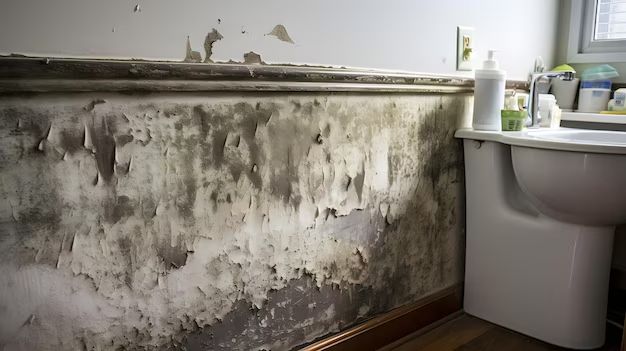Mold growth is a common problem in bathrooms due to the warm, humid conditions that allow mold spores to thrive. Selecting the right paint is an important step to prevent mold from recurring and spreading in your bathroom.
Page Contents
Anti-Mold Paint
Using anti-mold paint is the most effective way to prevent mold growth on bathroom walls and ceilings. Anti-mold paints contain special additives that help resist mold and mildew.
There are two main types of anti-mold paints:
- Mildew-resistant paints – These contain fungicides and mildewcides that prevent mold spores from growing on the paint surface.
- Mold- and mildew-proof paints – These have acrylic resins that encapsulate the paint film, preventing moisture and mold spores from penetrating the coating.
Anti-mold paints are available in various sheens like flat, eggshell, semi-gloss etc. Flat and matte finishes may be preferable for bathroom walls and ceilings as they hide flaws better.
Top Anti-Mold Paint Brands
Some top quality anti-mold paint brands include:
- Zinsser Mold Killing Primer – Water-based fungicidal coating that kills and prevents mold and mildew growth.
- Rust-Oleum Mold Killing Primer – Oil-based primer that fights existing mold and prevents new mold growth.
- KILZ Premium Mold & Mildew Resistant Interior Paint – Acrylic paint with antimicrobial technology to resist mold regrowth.
- PPG Perma-White Mold & Mildew-Proof Interior Paint – 100% acrylic formula blocks moisture and resists mold and mildew.
- Behr Premium Plus Interior Ceiling Paint – Contains agents to prevent mold and mildew growth on ceilings.
How Does Anti-Mold Paint Work?
Anti-mold paints work through two main mechanisms:
- Using biocides – Anti-mold paints contain antimicrobial ingredients called biocides that kill mold, mildew and fungus. The biocides leach through the paint film and disrupt the cell membranes of the mold spores, killing them.
- Moisture resistance – Anti-mold paints use polymers and resins that create a moisture-resistant barrier on the painted surface. This prevents water from penetrating the paint layer and depriving mold of the moisture needed for growth.
The biocides remain active for several years in the coating, so the anti-mold protection lasts over time. However, antibacterial activity diminishes gradually as the biocides leach out.
Preparing Surfaces for Anti-Mold Paint
Proper surface preparation is crucial before painting bathroom walls and ceilings with anti-mold paint:
- Clean surfaces thoroughly to remove all visible mold, mildew and soap scum with an antimicrobial cleaner.
- Remove existing peeling or chipped paint using sanders, scrapers or wire brushes.
- Kill and remove any remaining mold with a mold killing primer like Zinsser Mold Killing Primer.
- Fill any holes or cracks with spackling paste to prevent moisture getting in.
- Sand surfaces to roughen them up so the paint adheres well.
- Wash walls with trisodium phosphate (TSP) if there is heavy soap scum buildup.
- Allow all cleaned surfaces to fully dry before painting.
How to Apply Anti-Mold Paint
Follow these tips when applying anti-mold paint:
- Read and follow the manufacturer’s instructions for application and drying times.
- Use good quality brushes and rollers suited for water-based paints.
- Apply a uniform coat and maintain a wet edge to prevent lap marks.
- Allow proper drying time between coats as specified by the manufacturer.
- For new drywall, apply primer before the anti-mold paint.
- Wear protective gear like goggles, gloves and mask to avoid exposure to biocides.
- Maintain good ventilation during painting to allow fumes to escape.
Typically two coats of anti-mold paint are recommended for best results and longevity. The paint forms a moisture-resistant film that prevents mold recurring for years.
How Often to Repaint with Anti-Mold Paint
Here are some general guidelines on when to repaint bathroom walls and ceilings with anti-mold paint:
- Repaint every 2-3 years if there are signs of mold or mildew recurring.
- Repaint every 3-4 years if existing paint is still in good condition with no mold issues.
- Repaint immediately if there is any visible moisture damage or flaking.
- Repaint when doing major bathroom renovations.
- Repaint if you notice the paint fading, yellowing or peeling.
However, several factors affect the repainting frequency like amount of moisture, ventilation, type of paint used previously etc. Inspect painted surfaces regularly and repaint at the first signs of mold or paint failure.
Tips for Effective Anti-Mold Protection
Here are some useful tips for getting the most out of anti-mold paint in your bathroom:
- Always clean existing mold thoroughly before painting.
- Use exhaust fans and open windows regularly to control humidity.
- Look for paint with EPA registered anti-microbial additives.
- Apply paint liberally to get the stated mil thickness for proper coverage.
- Caulk gaps around windows, outlets and pipes to prevent moisture entry.
- Consider applying two coats of anti-mold primer for severely molded areas.
- Don’t paint over dirty or soap scummed surfaces.
In addition to using anti-mold paint, ventilating the bathroom properly is key to preventing recurring mold issues.
Conclusion
Anti-mold paints provide a reliable coating to resist ugly and damaging mold growth in bathrooms. Choose top quality paint with EPA registered biocides, prepare surfaces thoroughly and apply the paint correctly. Renew the anti-mold coating every few years before it loses effectiveness. Combine with proper ventilation and moisture control for a mold-free bathroom that stays protected for years.
